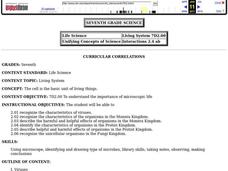Teach Engineering
Edible Algae Models
Sometimes it's okay to eat your science experiment. A hands-on activity has pupils create models for algae to learn about its cellular structure. The best part of the experiment? The resulting juice-filled gels are edible—yum!
K12 Reader
What’s in Your Cells?
Organelles, cellular respiration, ATP, and DNA. The passage attached to this life science reading comprehension instructional activity is all about cells. After reading about diffusion and osmosis, kids answer a series of questions based...
Teach Engineering
Algae: Tiny Plants with Big Energy Potential
My, what big energy potential you have! Scholars learn about the energy potential of using algae as a biofuel. A PowerPoint presentation first describes the structure of algae and then how researchers use algae as biofuel to produce energy.
Curated OER
Algae: An Overview
The main characteristics and definitive features of red, green, brown, and 4 other algea are listed along with great photos and examples. The details involved with reproduction styles, and information about traits of each Phyla are...
Curated OER
Algae Part One: An Introduction
Young scholars have the opportunity to view two types of algae under 400x magnification with a compound microscope. They make observations and record their observations through drawings and words. In addition, they identify different...
Curated OER
Introduction to Algae
Students explore different types of algae found in both local regions of Salt Lake and different parts of the world. They discover different types of algae found in an ecosystem and the significance and function it serves.
Curated OER
Review of Cell Organelles
In this cell organelles worksheet, students read the structure and function of different plant and animal cell organelles to determine what organelle is being described. Students write in the 15 organelles into a chart.
Curated OER
Cell Structure and Function
Students discuss scientific advances brought about by the Mars Surveyor Space Program which impact on daily life, identify laboratory apparatus like microscopes, slides and coverslips, and use the microscopes to view cells and organisms.
Curated OER
WET Science Lesson #5: Pass the Salt Please! (How Road Salt Affects Wetlands)
As an anticipatory set, biologists listen to the story of Ruth Patrick, a scientist who used algae to detect water quality. They observe a demonstration of osmosis and diffusion. In their lab groups, they place Elodea stalks in...
Curated OER
Algae Blooms
Your microbiologists explore a changing algae population and build an exponential function modeling algae concentration from the description given of the relationship between concentrations in cells/ml and days of rapid growth.
Curated OER
Energy in a Cell
In this cell energy worksheet, students are given clues about the light capturing process in plants and the energy producing reactions in animals to complete a crossword puzzle.
Curated OER
Algae
In this biology worksheet, students identify and locate various vocabulary terms pertaining to algae. There are 54 biology terms located in the word search.
Curated OER
Prokaryotes and Eukaryotes
Examine cyanobacteria cells as an example of prokaryotes and several other alga as examples of eukaryotes. Future biologists compare the two and notice the absence of nuclei in prokaryotes. These are classic activities for this purpose,...
Curated OER
Cells
Seventh graders look up pictures of viruses or pictures of models of viruses. Using pipe cleaners, beads, Styrofoam or other available materials make models of these shapes. They then observe a demonstration to show the effect of Tobacco...
Curated OER
Generation of Action Potentials in Nitella Giant Algal Cells
Learners observe cytoplasmic streaming in Nitella cells. They examine the conduction of a wave of depolarization across other membranes, such as the axons of neurons. Students predict the effects of sending a small electric current...
Curated OER
Eutrophication
Students observe the effects of eutrophication and determine why it is harmful to aquatic ecosystems. They create mason jar ecosystems to observe the growth of algae in pond water. In addition, they observe the effect of introducing...
Curated OER
Great Salt Lake
Third graders are introduced to the Great Salt Lake (GSL) environment and the various components of it. They make observations about algae and its environment and discuss why it is considered a living organism and various components of...
Curated OER
Characteristics of Plants
In this characteristics of plants activity, students name two things that all plants have in common. Then they describe how the cell walls and cuticles help plants adapt to life on land. Students also explain the difference between...
Curated OER
Bad Algae!
Learners explore algal blooms. In this ecosystem and health lesson, students define and describe harmful algal blooms, then discuss ways in which the impact of these algal blooms could be reduced. Learners work in groups to research...
Curated OER
Kingdoms of All Living Things
In this biology worksheet, students identify and locate various vocabulary terms related to the kingdoms of all living things found on earth. There are 24 biology terms located in the word search.
Curated OER
Diversity of Life
Students identify the difference between eukaryote and prokaryotes and examine the structure of bacteria. In this bacteria lesson students examine the different ways that bacteria are classified through an activity.
Curated OER
Protists
In this protists learning exercise, students will use idea maps about plantlike protist and funguslike protist characteristics to complete 4 short answer questions.
Curated OER
Protists
In this protists worksheet, students will review the different types of protists and the different stages of the protist life cycle. This worksheet has 10 matching questions.
Curated OER
Chloroplasts
Learners study chloroplasts, their structure and evolution. In this photosynthesis lesson students experiment with polarized light and the production of chlorophyll.

























